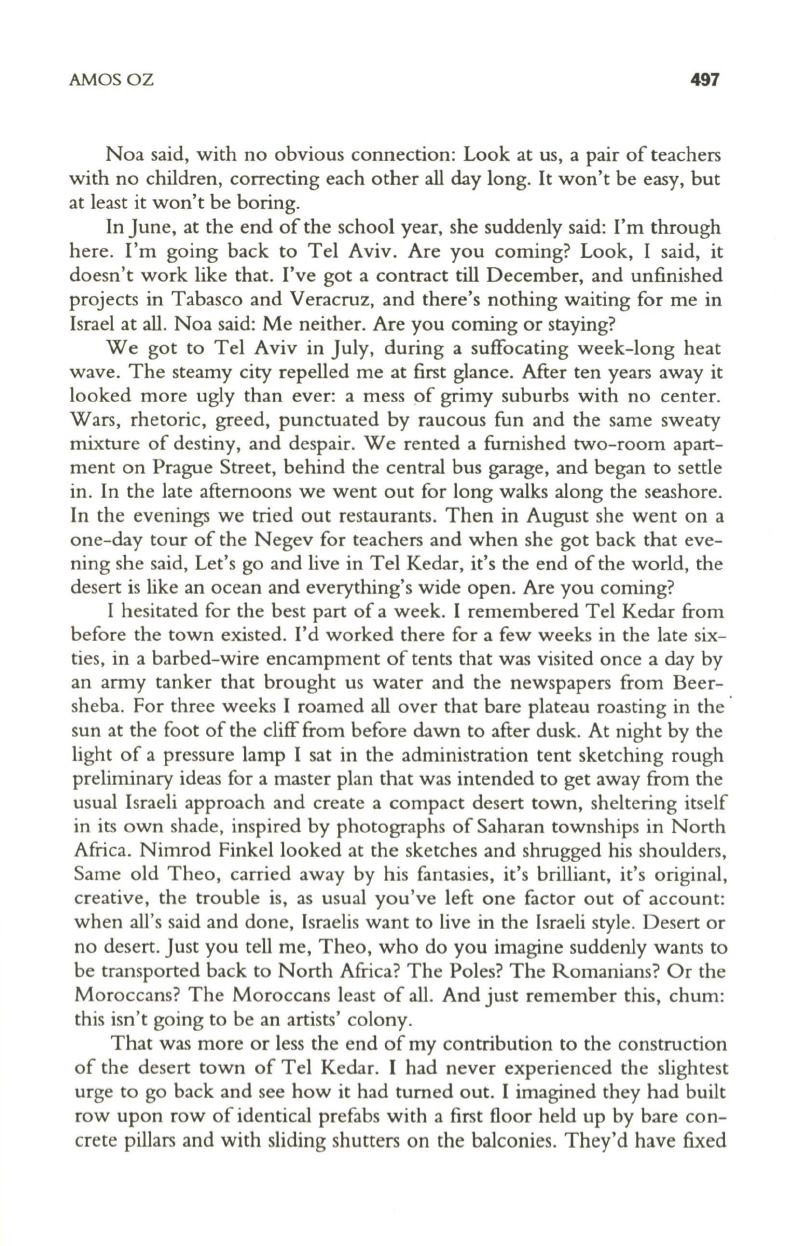
AMOSOZ
497
Noa said, with no obvious connection: Look at us, a pair of teachers
with no children, correcting each other all day long. It won't be easy, but
at least it won't be boring.
In June, at the end of the school year, she suddenly said: I'm through
here. I'm going back to Tel Aviv. Are you coming? Look, I said, it
doesn't work like that. I've got a contract till December, and unfinished
projects in Tabasco and Veracruz, and there's nothing waiting for me in
Israel at all. Noa said: Me neither. Are you coming or staying?
We got to Tel Aviv in July, during a suffocating week-long heat
wave. The steamy city repelled me at first glance. After ten years away it
looked more ugly than ever: a mess pf grimy suburbs with no center.
Wars, rhetoric, greed, punctuated by raucous fun and the same sweaty
mixture of destiny, and despair. We rented a furnished two-room apart–
ment on Prague Street, behind the central bus garage, and began to settle
in. In the late afternoons we went out for long walks along the seashore.
In the evenings we tried out restaurants. Then in August she went on a
one-day tour of the Negev for teachers and when she got back that eve–
ning she said, Let's go and live in Tel Kedar, it's the end of the world, the
desert is like an ocean and everything's wide open. Are you coming?
I hesitated for the best part of a week. I remembered Tel Kedar from
before the town existed. I'd worked there for a few weeks in the late six–
ties, in a barbed-wire encampment of tents that was visited once a day by
an army tanker that brought us water and the newspapers from Beer–
sheba. For three weeks I roamed all over that bare plateau roasting in the
sun at the foot of the cliff from before dawn to after dusk. At night by the
light of a pressure lamp I sat in the administration tent sketching rough
preliminary ideas for a master plan that was intended to get away from the
usual Israeli approach and create a compact desert town, sheltering itself
in its own shade, inspired by photographs of Saharan townships in North
Africa. Nimrod Finkel looked at the sketches and shrugged his shoulders,
Same old Theo, carried away by his fantasies, it's brilliant, it's original,
creative, the trouble is, as usual you've left one factor out of account:
when all's said and done, Israelis want to live in the Israeli style. Desert or
no desert. Just you tell me, Theo, who do you imagine suddenly wants to
be transported back to North Africa? The Poles? The Romanians? Or the
Moroccans? The Moroccans least of all. And just remember this, chum:
this isn't going to be an artists' colony.
That was more or less the end of my contribution to the construction
of the desert town of Tel Kedar. I had never experienced the slightest
urge to go back and see how it had turned out. I imagined they had built
row upon row of identical prefabs with a first floor held up by bare con–
crete pillars and with sliding shutters on the balconies. They'd have fixed


